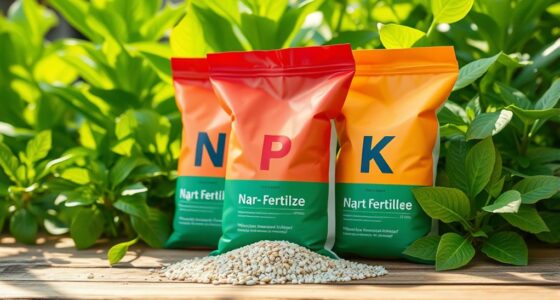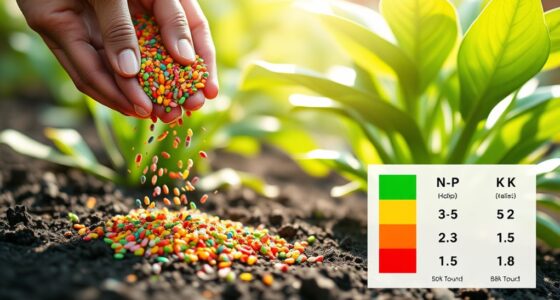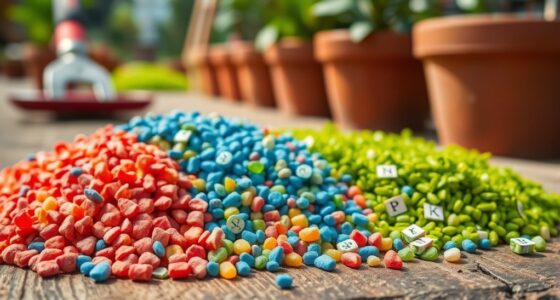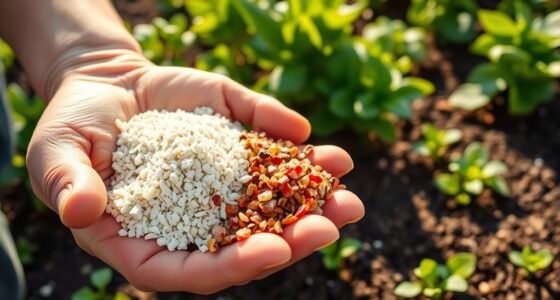Understanding N-P-K ratios helps you choose the right fertilizer for your plants’ needs. Nitrogen (N) promotes leafy, green growth, while Phosphorus (P) supports roots and flowering. Potassium (K) improves overall resilience and fruit quality. Knowing what your plants require at different stages allows you to avoid over- or under-fertilizing. If you’re curious about how to tailor fertilization to your garden, you’ll find useful tips as you explore further.
Key Takeaways
- N-P-K ratios indicate the relative amounts of nitrogen, phosphorus, and potassium in fertilizers, guiding plant nutrient needs.
- Nitrogen promotes leafy, vegetative growth, while phosphorus supports roots and flowering, and potassium enhances overall plant health.
- Soil testing helps determine existing nutrient levels and pH to choose appropriate fertilizers with correct N-P-K ratios.
- Different growth stages require tailored fertilization; young plants need balanced nutrients, mature plants benefit from potassium during flowering.
- Over- or under-fertilizing can harm plants; monitoring and adjusting based on plant response ensures optimal soil fertility.

Fertilizer 101 introduces you to the basics of boosting plant growth and soil health. If you’re looking to improve your garden’s vitality, understanding how fertilizers work is essential. One way to start is by exploring organic alternatives—these are natural options like compost, manure, and plant-based products that enrich your soil without synthetic chemicals. Organic fertilizers not only support healthy plant development but also help maintain ecological balance. Before applying any fertilizer, it’s crucial to perform soil testing. Soil testing provides detailed information about your soil’s nutrient content, pH level, and deficiencies, allowing you to tailor your fertilization approach effectively. Without this step, you might over-fertilize, wasting resources or harming your plants, or under-fertilize, leading to poor growth.
Once you know your soil’s specific needs, you can choose a fertilizer that supplies the right balance of nutrients. The key elements to consider are nitrogen (N), phosphorus (P), and potassium (K), often represented as N-P-K ratios on fertilizer labels. These nutrients serve different purposes: nitrogen promotes lush, leafy growth; phosphorus encourages healthy root development and flowering; potassium enhances overall plant resilience and fruit quality. Understanding these roles helps you select a fertilizer that addresses your plants’ particular stage of growth and health.
Applying the correct fertilizer involves more than just picking a product with the right N-P-K ratio. You need to consider the timing, quantity, and method of application. For instance, young seedlings require a gentle, balanced fertilizer, while mature plants might benefit from a boost of potassium during flowering. Over-fertilizing can lead to nutrient runoff, pollution, and even plant damage, so always follow recommended application rates. Incorporate fertilizers into your soil carefully, either by mixing them into the topsoil or watering them in, depending on the type of fertilizer used.
Monitoring your plants after fertilizing is vital. Watch for signs of nutrient deficiencies or excesses, such as yellowing leaves or stunted growth, and adjust your fertilization routine accordingly. Using soil testing periodically helps you stay on track, ensuring your plants receive what they need without overdoing it. Additionally, understanding the causes of nutrient imbalances can help prevent common issues related to improper fertilization. Combining this knowledge with organic alternatives and proper testing creates a sustainable, effective approach to plant care that promotes healthy growth and soil vitality. By understanding the basics of N-P-K and your soil’s specific requirements, you set yourself up for a thriving, vibrant garden.
Frequently Asked Questions
How Often Should I Fertilize My Plants?
You should fertilize your plants based on their specific needs and growth cycle. Typically, it’s best to follow a consistent watering schedule and apply fertilizer during active growth periods. For most plants, fertilizing every 4-6 weeks works well, but always pay attention to signs of over- or under-fertilization. Adjust your fertilizer application timing accordingly, ensuring it complements your watering routine for healthy, thriving plants.
Can I Use Synthetic Fertilizers on Organic Plants?
Oh, the irony of mixing synthetic fertilizers with organic plant compatibility, right? You can technically use synthetic fertilizers on organic plants, but it defeats the purpose. Synthetic fertilizers often contain chemicals that may harm your organic system or compromise its integrity. If you want truly organic results, stick with organic fertilizers. Your plants will appreciate the consistency, and you’ll keep your organic gardening principles intact.
What Are Signs of Over-Fertilization?
You might notice nutrient toxicity signs if you over-fertilize your plants. Look for plant symptoms like leaf burn, yellowing, or stunted growth, which indicate over-application of nutrients. Excess fertilizer causes nutrient buildup, leading to toxicity that harms your plants. To prevent this, follow recommended application rates and avoid frequent, heavy feeding. Monitoring your plants regularly helps catch over-fertilization early and keeps them healthy.
Are There Eco-Friendly Fertilizer Options Available?
You ask if eco-friendly fertilizer options exist. Yes, you can explore compost alternatives and organic nutrient sources that are gentle on the environment. These options include composted plant materials, fish emulsion, and seaweed extracts, which enrich soil naturally. Using organic fertilizers helps reduce chemical runoff and supports sustainable gardening. Incorporating these eco-friendly choices guarantees your plants thrive while protecting the planet.
How Does Soil Ph Affect Fertilizer Effectiveness?
Soil pH crucially impacts fertilizer effectiveness by influencing soil acidity and nutrient availability. When your soil is too acidic or alkaline, certain nutrients become less available to plants, hindering growth. To optimize fertilizer use, test your soil’s pH regularly and adjust it if needed. Maintaining the right pH level ensures nutrients are accessible, boosting your plants’ health and growth, and making your fertilizer efforts more efficient.
Conclusion
Think of your garden as a symphony, with each plant playing its part. Fertilizer is your conductor, guiding the harmony of N-P-K to produce vibrant blooms and healthy growth. When you understand these nutrients, you become the maestro, tuning each section perfectly. With mindful feeding, your garden orchestra will flourish, creating a masterpiece that reflects your care and knowledge. Embrace the rhythm, and watch your plants thrive in beautiful harmony.









